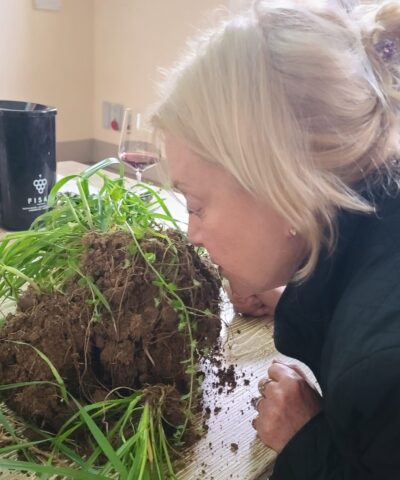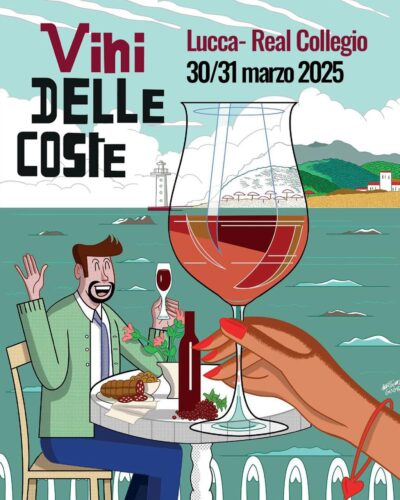Sticking our noses in glasses is all part of the work we do tasting and writing about wine. But during a master class held at Vini Delle Coste we found ourselves nosing large chunks of dirt freshly dug up and brought in from different vineyards. The presentation was led by Lucchese vintner Saverio Petrilli to understand the four expressions of Luccan Hills terroir from the ground up.
The inaugural Vini Delle Coste was held March 30-31 in Lucca at the Real Collegio, a former basilica dating to the sixth century. The program celebrated coastal winemaking in Italy, many smaller independent producers. Eighty wine producers from across Italy came together to meet over 1,200 visitors, including wine lovers and industry professionals. We were honored to be invited to attend, and it was our first time visiting the lovely city of Lucca which is rich in history, music, architecture and design and, of course, culinary offerings
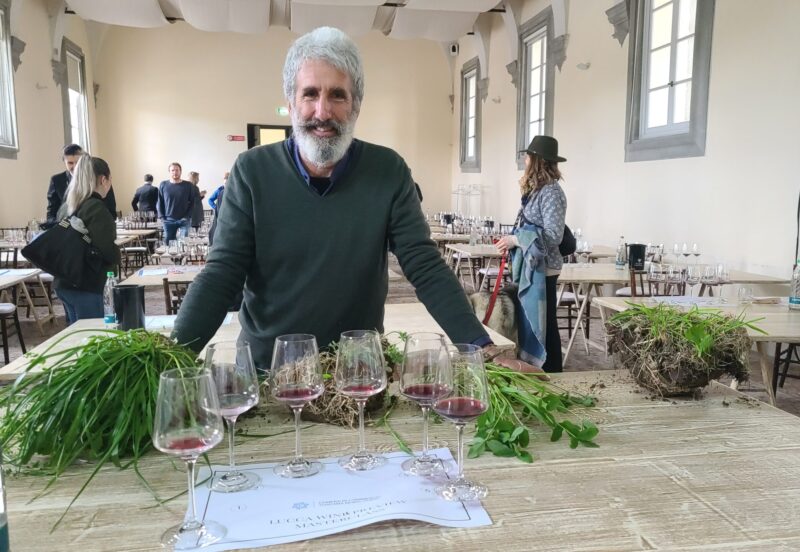
Saverio Petrilli brought soil samples to his master class
Activities were well-organized and scheduled, providing us ample time to meet producers and taste wines from Tuscany, Liguria, Emilia-Romagna, Marche, and Abruzzo. There was also a showcase dedicated to artisan foods from Lucca and Pisa as well as a gastronomic program entitled Condimenti led by celebrity Chef Cristiano Tomei.
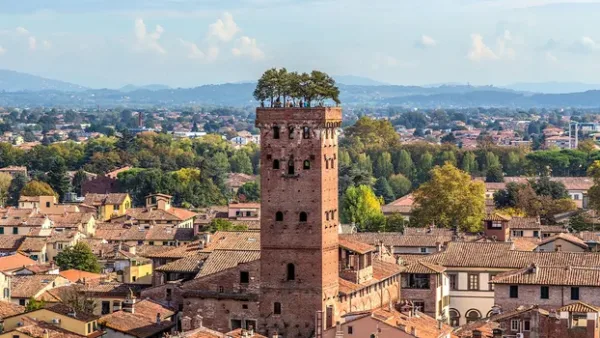
Vini Delle Coste took place in Lucca, a stunning medieval walled city in Tuscany.
Vini Delle Coste Founder Alessandra Guidi told us she decided to dedicate a program to the wines of coastal Italy “to highlight lesser-known Italian wine producers located along the coast, showcasing how the sea and sun shape their unique expressions. The goal was to give visibility to small coastal wineries and create a space where their stories, terroirs, and wines could be discovered and appreciated.”
Even though we have visited Tuscany and attended Anteprime Tuscana several times, we had never been to Lucca or deep-dived into the wine of the Lucca Hills and Pisan Hills wine appellations and nearby areas of Montecarlo and Candia.

Master Class at Vini Delle Coste held at the Real Collegio
We attended three master classes:
Territorial Unity – LUCCA and Its Terroirs: Four Geological Eras, Four Expressions of Lucchese Terroir led by Saverio Petrilli, an agronomist and winemaker who is considered a pioneer in the region for promoting biodynamic and organic practices. and vintner. We had dinner with Petrilli while in Lucca and learned he has served as the winemaker for Tenuta di Valgiano, a leading producer whose wines we recommend. We hope to visit Valgiano next time we are in this region.
Vintage 2016: A Journey in the Glass from Lucca to Pisa – Colline Lucchesi – Montecarlo – Terre di Pisa led by Richard Baudains, a wine writer who lives in Italy This tasting allowed us to compare and contrast the wines of Terre di Pisa and Colline Lucchesi and Montecarlo.
Alpine Wines by the Sea – Heroic Viticulture from Lucca to Massa Carrara, another guided tasting led by Silvia Baratta, Founder of Gheusis, a communications firm involved with Vine Delle Coste and producer, Andre Elmi, owner of Maestà della Formica (see our blog post here Tasting Field Blends with Andrea Elmi, Maestà della Formica – The Connected Table)
Notable about the wines produced in the Lucca region is that more than 70 percent are biodynamic. Also, many of the wines are field blends with the winemaker deciding what varieties to use and amounts. This is in stark contrast to DOC and DOCG wines that must follow strict guidelines for production.
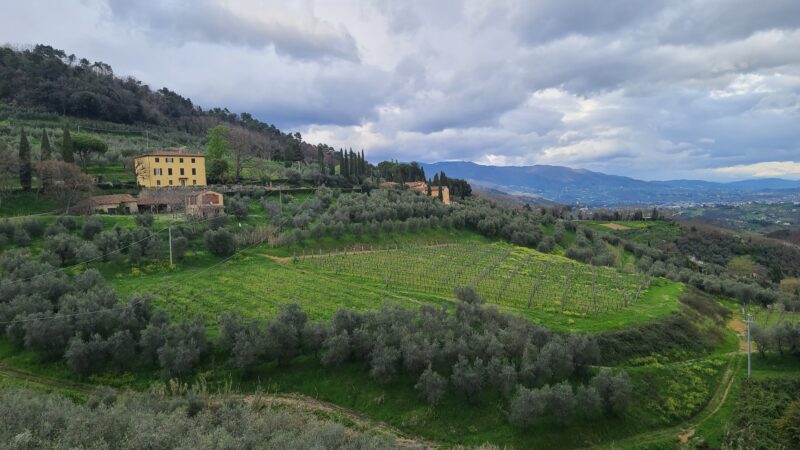
Lucca is in the north of Tuscany situated between the Tyrrhenian Sea and the Apennine Mountains. Many vineyards are at higher altitudes. Breezes both from the sea and the mountains help purify and cool the air around the vineyards. Warm days, cool nights and soils of clay, marl and limestone help produce wines that deliver excellent minerality and freshness with potential for longer aging.
Here are three producers whom we met and spent time tasting their wines:
Calafata Portovino is part of a collective cofounded by ten friends who pooled resources to acquire abandoned vines on clay and limestone soils to farm and make wine. None of friends had formal winemaking training but they all had a shared passion and vision. Today the collective members are from Italy, France, Germany and Austria.
Cofounder Mauro Montanaro told us that Calafata PortoVino started as a passion project with a social cause. “We were the first winery to be a Società Cooperativa Sociale in Tuscany, helping kids that were in exile, kids that had drug problems, mental issues, or wanted to begin a life again after being in jail. We’re now a big crazy group.”
Since Calafata’s founding 15 years ago the social cause has furthered its social mission which includes hiring individuals who are disabled and refugees seeking asylum
Calafata’s motto is “In ground we trust: work the land with rigor, passion and craziness.” Currently Calafata has nine hectares of vineyards, three hectares of olive groves and eight hectares for farming vegetables including the local specialty, Fagioli Rossi di Lucca.

Vineyards for Calafata in the Colline Lucchese
The group is committed to biodynamic farming and minimal intervention to make their wines. Montanara said that the wines are often mistaken for natural wines in the marketplace. “This is my problem. I make very non funky wines with funky labels.”
Examples:
Gronda Bianco IGT Toscana is an aromatic white field blend whose dominant varieties are Vermentino and Malvasia Bianco with 24-hour skin contact. The label depicts an elk with large antlers bathing in a metal tub.
Scapigliato IGT Toscana is described as a “vino di merenda” (easy to drink). It’s a light bodied red made from a blend of different varieties and is fermented in stainless steel. Definitely a quaffing wine. The word “scapigliato” means “messy hair. The label depicts a nattily dressed man with the head of an elk with large antlers.
Majulina Rosso IGT Toscana is a blend of 60% Sangiovese with smaller percentages of Canaiolo, Colorino and Ciliegiolo aged in concrete. Full bodied, it delivered bright berry notes. The label depicts a woman with the head of an oryx holding a saxophone.
Iasera Rosso 2022 IGT Toscana is 100% Sangiovese age in concrete and then one year in bottle. This is ripe, silky red with notes of red cherry and balsam. The name “Iasera” is local slang for Ieri sera / last night. The label depicts a bird dressed as a woman riding a bicycle.
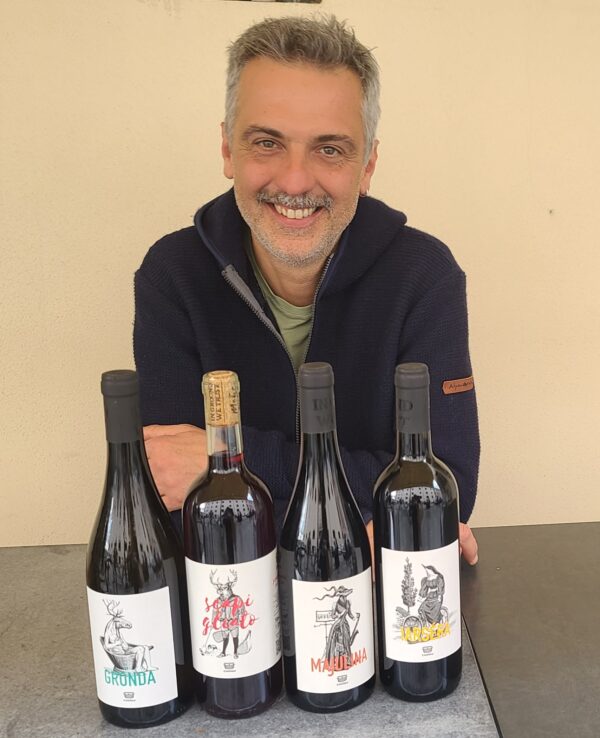
Calafata Cofounder Mauro Montanaro Website
In contrast to the free-spirit personality of Calafata, Villa Santo Stefano conveys modern luxury with elaborate manicured gardens and a stately villa. One underground building houses the current owner’s car collection. The estate was once owned by the Bertolli family. Olive oil is also a big cash crop here in addition to wine. In 2001, the 34-hectare estate was acquired by German industrialist, Wolfgang Reitzle, and renamed Villa Santo Stefano to recognize the nearby Pieve Santo Stefano.
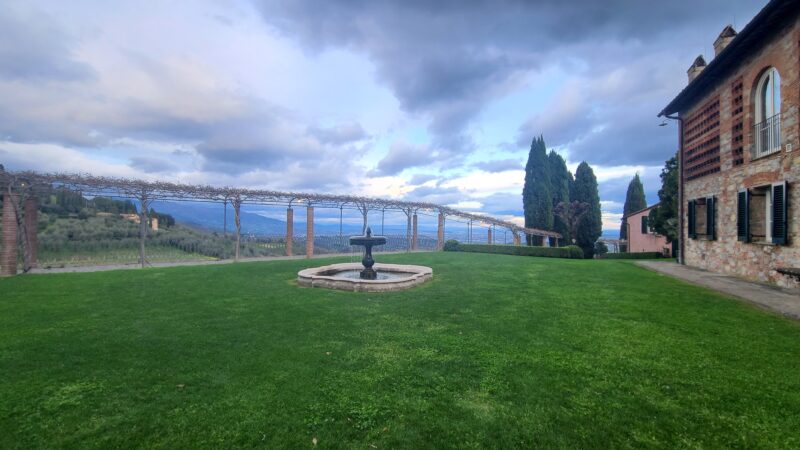
View from Villa Santo Stefano, formerly the estate of a major olive oil producer
Villa Santo Stefano produces 60,000 bottles of red, rosé and white wines along with 1500 liters of olive oil. Production is all organic. The winemaker is Alessio Farnesi who previously worked with La Spinetta in Piemonte.
We tasted six wines and a few olive oils. Standout wines included:
Gioia IGT Toscana a white made from 100% Vermentino aged six months in stainless steel. This is a classic Tuscan Vermentino with notes of lemon, ginestra and sea spray and pleasant minerality.
Loto 2021 IGT Toscanais a blend of 50% Cabernet Sauvignon, 30% Merlot, 10% Petit Verdot and 10% Cabernet Franc aged 16 months in new barrique. This is an elegant, full bodied red with hints of dark cherry, cassis, vanilla, white pepper, tree bark and smoke. Grapes are sourced from the Maremma and Grosseto.
Nina IGT Toscana is made from 100% Cabernet Franc aged 14 months in French tonneau. This wine delivers powerful tannins and a punch of acidity with notes of blackberry, blueberry, anise and bell pepper. Nina is named for Wolfgang Reitzle’s wife.
Maestà della Formica translates to the “Majesty of the Ant.” The winery is named after a nearby mountain pass in the Apuan Alps and is near Garfagnana about an hour and a half north of Lucca. At 1050 meters above sea level, this is a wild and remote mountain area. The 3.2 hectares of vineyards are all farmed biodynamically and range from 50 to 150 years old.
Andrea Elmi, cofounder of Maestà della Formica with Marco Raffaeli, met while studying viticulture and oenology at the University of Pisa. After working with different wineries in Tuscany, they joined forces to establish Maestà della Formica in 2013 and released their first wine in 2018. Maestà della Formica’s wines are all IGT. Many are field blends which is another distinguishing characteristic of the wines made in this wild west part of Tuscany where terroir is key. Grapes are mixed together in small parcels resulting in a mélange that could include reds blended with small amounts of Sangiovese, Syrah, Cilegiolo, Canaiolo, Gamay, Blaufränkisch and Abrusco (among others). Maestà della Formica’s main whites are made with Riesling, Vermentino, Trebbiano and Malvasia.

Andrea Elmi, cofounder of Maestà della Formica
Three examples from the wines we tasted:
Riesling Renano IGT Toscana, both 2022 and 2023 vintages. Grapes are sourced from vineyards at 1050 meters planted in soils of sand, silt and a little clay. Aromatic with notes of peach, green apple, lime with floral notes of elderflower and jasmine. Flinty with firm acidity.
Gamo Rosso 2023 IGT Toscana, a blend of Syrah, Cilegiolo, Sangiovese, Gamay, Bonarda and Abrusca. After five days of maceration, the wine is refermented in bottle using unfermented must from the same vineyards. Zero sulfur added.
DrankAnte 2022 IGT Toscana a light, chillable frizzante red wine blend- 30% Sangiovese, 30%
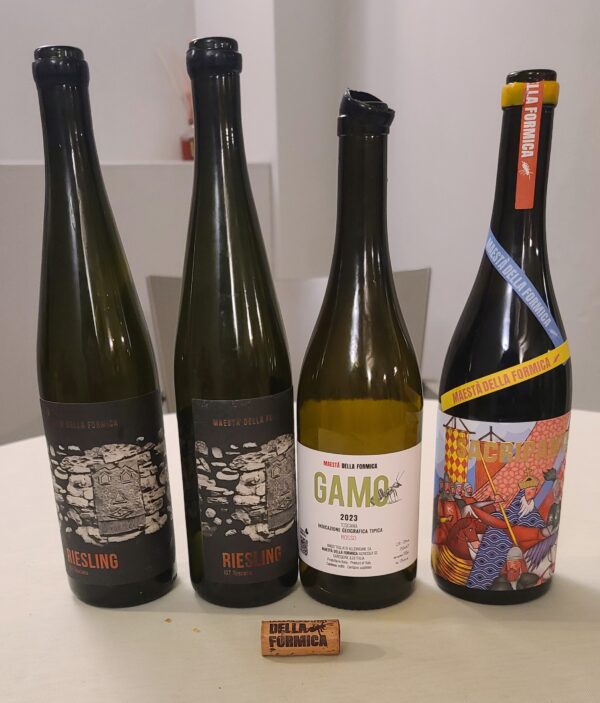
www.maestadellaformica.com U.S. Importer: David Bowler Wines.
Following the success of this first year, plans are moving forward to expand Vini Delle Coste to include more coastal areas throughout Italy. “With over 8000 km of coastline, Italy offers endless potential, and we hope to involve more regions and producers as the event grows, celebrating the diversity of coastal winemaking,” Alessandra Guidi told us.
We hope to make a return visit and spend more time traveling throughout Italy’s varied coasts.
